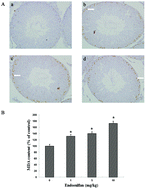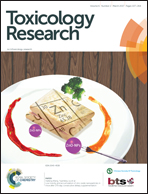Endosulfan induces apoptosis by activating the negative regulation pathway of cell cycle and death receptor pathway in spermatogenic cells
Abstract
The male reproductive toxicity of endosulfan has been proved. Nevertheless, the underlying molecular mechanisms of the apoptosis caused by endosulfan in spermatogenic cells remains poorly understood. In order to investigate the reproductive toxicity mechanism caused by endosulfan, there were four groups, which had eight Wistar male rats randomly assigned to them, and the rats in different groups received different doses of endosulfan for a period of 21 days. GC-1 spermatogenic cell lines were divided into four groups, and each group was exposed to different doses of endosulfan for 24 hours. The results of this research showed that endosulfan decreased the cell viability, damaged cell membranes and induced apoptosis in spermatogenic cells. Endosulfan had obviously activated the protein expression of PKC-δ, p53, p21cip1, p27kip1, Fas, FasL, Caspase-8, Caspase-3, and inhibited the expression of E2F-1. Endosulfan also induced oxidative stress and DNA damage in spermatogenic cells. The results of this research suggested that endosulfan could lead to E2F-1-induced apoptosis of spermatogenic cells by activating the negative regulation factors of the cell cycle, and endosulfan might cause apoptosis by death receptor pathway, causing oxidative stress.


 Please wait while we load your content...
Please wait while we load your content...